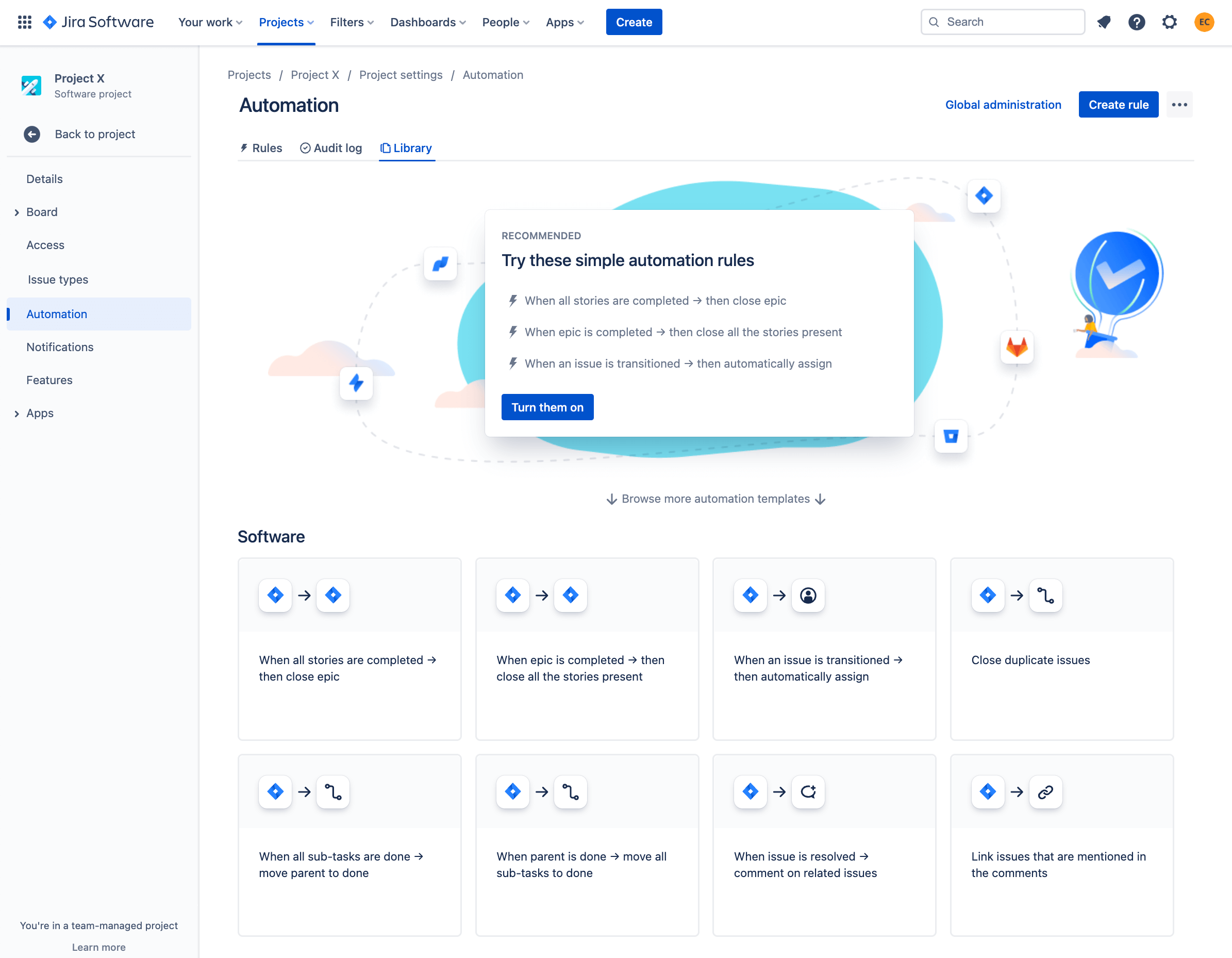Automatización de Jira: aspectos básicos y casos de uso habituales
¿Qué es Automation?
La automatización permite a tus equipos programar sus tareas, procesos y flujos de trabajo, de modo que puedas centrarte en el trabajo que importa y no perder tiempo realizando tareas manuales repetitivas. Con nuestro sencillo creador de reglas sin código, puedes crear reglas de automatización para gestionarlo todo, desde las tareas repetitivas más sencillas hasta las situaciones más complejas, todo con solo unos clics.
La automatización está disponible actualmente en Jira Cloud y Confluence Cloud.
¿Cuáles son los elementos clave de las normas de automatización?
Las reglas de automatización se componen de tres partes: desencadenadores que ponen en marcha la regla, condiciones que la refinan y acciones que realizan tareas en tu sitio.
Triggers, conditions, and actions are the building blocks of automation. Simply combine these components to create rules that can do anything from auto-closing old work items to notifying specific teams when a release has been shipped.
Puedes encontrar algunas plantillas de automatización que te ayudarán a empezar con la biblioteca de productos.

Y tenemos muchas más plantillas y guías de automatización en la biblioteca de plantillas de automatización para que las utilices y aprendas.
¿Qué son los desencadenadores?
Every rule starts with a trigger. They kick off the execution of your rules. Triggers will listen for events in Jira, such as when a work item is created or when a field value is changed. You can also trigger rules to run from third party services like Bitbucket or GitHub.
Los desencadenadores se pueden configurar para que se ejecuten manualmente, en función de la condición que establezcas o programes.
¿Qué son las condiciones?
Conditions allow you to narrow the scope of your rule. They must be met for your rule to continue running. For example, you can set up your rule to only escalate a work item if it is high priority.
Si una condición falla, la regla deja de ejecutarse y no se realiza ninguna acción posterior.
¿Qué son las acciones?
Actions are the doers of your rule. They allow you to automate tasks and make changes within your site. They allow you to perform many tasks, such as editing a work item, sending a notification, or creating sub-tasks.
¿Qué son las ramas?
Work items in Jira rarely exist in isolation. They often contain sub-tasks, are stories that are part of a larger epic, or are simply linked to other work items using certain relationships. This means that when using automation, actions often need to apply, not only to the source work item that triggered the rule, but also to any work items that are related to the source work item.
Special conditions and actions are available to create powerful rules that can work across complex work item relationships. For example, checking that all sub-tasks of a parent work item are resolved.
¿Qué son los valores inteligentes?
Smart values allow you to access and manipulate a wide range of work item data within your site. They can add significant power and complexity to your rules. For example, the smart value {{now.plusDays(5)}} references the current time and adds 5 days to it, while {{issue.summary}} will print off the summary of the work item.
¿Qué es un actor de regla?
The rule actor is the user who executes a rule. This user must have the relevant permissions to trigger the rule, and complete any actions that may be performed. For example, if a rule is created that will comment on a work item when executed, the rule actor must have the Add comment permission, otherwise the rule will result in an error.
En tu sitio, el actor de la regla se establecerá como usuario de la aplicación de automatización. No obstante, puedes cambiar el actor de la regla de tus reglas de automatización.
¿Qué es el estado de una regla?
Puedes ver el estado de una regla de automatización para identificar si está activa o no. Si una regla está inactiva, no se ejecutará hasta que se habilite. El estado de una regla puede verse en su página de detalles.
- habilitada La regla está activa.
- deshabilitada La regla no está en uso en este momento.
- borrador La regla tiene cambios sin publicar.

¿Qué es un registro de auditoría?
Cada una de tus reglas cuenta con un registro de auditoría que puedes revisar para ver cuándo se ha activado, el resultado final de la ejecución y qué acciones se realizaron.
Puedes ver el registro de auditoría de una regla concreta, de un proyecto o a nivel global. Revisar los registros de auditoría es un modo efectivo de depurar las reglas.
